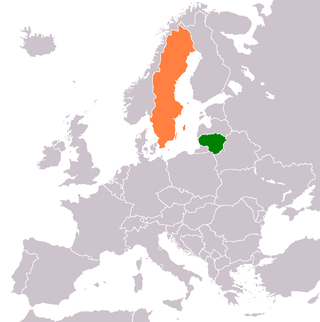
Carl Alexander Clerck was a Swedish entomologist and arachnologist.

Episinus angulatus is a small mottled brownish tangle-web spider, found from Europe to Russia.

Segestria senoculata, sometimes known as the snake-back spider, is a species of spider belonging to the family Segestriidae. It has a Palearctic distribution.

Enoplognatha ovata, the common candy-striped spider, is a species of spider belonging to the family Theridiidae. Their scientific name derives from the latin word 'ovatus' which means egg-shaped. Despite its small size, this is a formidable predator which can prey on insects many times its size.

Kungsträdgården is a station of the Stockholm metro, located in the district of Norrmalm. It is the end station of line 10 and line 11 and was opened on 30 October 1977, as the 91st station and part of the one-station extension from T-Centralen. The platform is located approximately 34 meters underground. The station features relics rescued from the many buildings pulled down during the redevelopment of central Stockholm during the 1950s and 1960s throughout the station.

Lithuania–Sweden relations are the foreign relations between Sweden and Lithuania. Sweden has an embassy in Vilnius. Lithuania has an embassy in Stockholm.

Dermanyssoidea is a superfamily of mites, including most of the mites which parasitise vertebrates.
During the Great Northern War (1700–1721), many towns and areas around the Baltic Sea and East-Central Europe had a severe outbreak of the plague with a peak from 1708 to 1712. This epidemic was probably part of a pandemic affecting an area from Central Asia to the Mediterranean. Most probably via Constantinople, it spread to Pińczów in southern Poland, where it was first recorded in a Swedish military hospital in 1702. The plague then followed trade, travel and army routes, reached the Baltic coast at Prussia in 1709, affected areas all around the Baltic Sea by 1711 and reached Hamburg by 1712. Therefore, the course of the war and the course of the plague mutually affected each other: while soldiers and refugees were often agents of the plague, the death toll in the military as well as the depopulation of towns and rural areas sometimes severely impacted the ability to resist enemy forces or to supply troops.
Fauna of Lithuania may refer to:

Harpactea rubicunda is a spider species found in Georgia. It is also found in Lithuania.

Ero cambridgei is a pirate spider species with Palearctic distribution. It is notably found in Lithuania.

Ero furcata is a pirate spider species with Palearctic distribution. It is notably found in Lithuania and the Czech Republic.

Hyptiotes paradoxus, also known as the triangle spider, is a cribellate orbweaver in the family Uloboridae.

Crustulina guttata is a spider species with Palearctic distribution. It is notably found in Lithuania.
Cryptachaea riparia is a spider species with Palearctic distribution. It is notably found in Lithuania.

Enoplognatha thoracica is a spider species with Holarctic distribution. It is notably found in Lithuania.

Euryopis flavomaculata is a tangle-web spider species with Palearctic distribution. It is notably found in Lithuania.

Platnickina tincta is a tangle web spider species with Holarctic distribution. It is notably found in Lithuania.

Lasaeola prona is a tangle web spider species with Holarctic distribution. It is notably found in Lithuania.
Lasaeola tristis is a tangle web spider species found from Europe to Central Asia. It is notably found in Lithuania.














